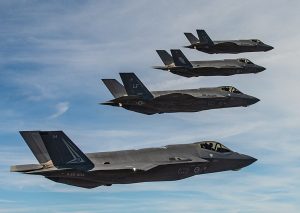The F-35 has become the centerpiece of the air forces of a growing number of Western nations. The interoperability of the aircraft’s operations and sustainment systems is recognized as a force multiplier in the delivery of combat air power, whether deployed to blunt Russian aggression in Europe or challenge China’s rise to dominance in the Indo-Pacific region.
The selection by two friendly but non-NATO countries, Finland and Switzerland, of the F-35 fighter is further testimony to the capabilities and success of the fifth-generation frontline fighter, which is in operation with Western air forces around the globe. The decision to operate the aircraft is driven in large measure by the requirement for a fighter that is not obsolete by the time it reaches service, and which can evolve over the aircraft’s four-decade-long expected lifecycle, during which it will be developed and upgraded, enabling it to maintain superiority over Russian and Chinese rivals.
While the sheer performance and range of capabilities of the aircraft’s stealth sensor and strike abilities are well-known, the technical interoperability of the F-35 is a crucial factor in delivering consistent front-line capability. That interoperability also strengthens U.S.-led global alliances. The global appeal of the aircraft underscores the recognition among Western governments and their militaries that interoperability is not just desirable; it is a necessity.
This interoperability is more than allies coordinating and communicating their efforts. It is integration at the level of the operating platform, a capability seamlessly demonstrated by the inclusion of an U.S. Marine Corps F-35B squadron in the air wing of the Royal Navy carrier battlegroup based on the HMS Queen Elizabeth. This level of integration offers decisive combat flexibility and has in no small measure energized the fifth-generation modernization of European and other allied air forces. It is widely seen as a major contribution to the enhancement of Western security and deterrence.
Such demonstration of the integrated fight and sustain capability is well-received from Europe to the Pacific, with partners from Norway to South Korea acknowledging the operational advantage F-35 interoperability provides and recognizing the program’s procurement and sustainment role in improving and binding international contributions toward collective defense and security. The global partnership of six program partner nations has influenced and driven the project, to create a growing stable of operators and potential customers.
Against this success, the U.S. decision to begin serious consideration of retrofitting Adaptive Engine Transition Program (AETP) technology to its fleet of F-35 aircraft may raise eyebrows in the defense ministries and departments of the many allies and prospective operators of the aircraft. While the level of ambition to provide the significant improvements in performance and endurance the AETP promises is consistent with the vision for the F-35, undertaking such a change is technically complex and carries large financial risk. The budgeting for this initiative is not in place and it is acknowledged that an AETP retrofit program could only be made to work in the F-35A and F-35C variants.
Consideration of an AETP retrofit appears to be a unilateral one, driven by the needs of the single largest operator of the F-35, the U.S. Air Force. The F-35 propulsion system supplied by Pratt & Whitney is at the heart of F-35 performance capabilities. Shifting the program in the direction of the untested AETP, a program originally conceived to support development of sixth-generation fighter capability, may leave partners and allies wondering where the considerable technical and financial risk may eventually fall. These concerns are made sharper by the rapid timeframe for the AETP retrofit envisaged by Congress, with key influencers there suggesting the retrofit of the fleet with new propulsion systems could be complete by the end of 2027.
Whether allies will be forced to accept the AETP to maintain the much-vaunted global interoperability or will need to diverge by running on the current propulsion system, with its consequences on supply chain, sustainment, and interoperability, remains to be seen. An AETP retrofit could be particularly bad news for the only Tier One program partner, the United Kingdom, as well as Japan, which is the largest overseas purchaser of the F-35. The lack of design compatibility with the F-35B variant operated by both countries will have a major impact as it will closer to home in the United States, with the USMC.
All partner nations and operators of the F-35 recognize the aircraft must evolve to meet changing needs; that’s one of the reasons they participate, to keep their air power capability at the edge of design and performance. The AETP retrofit proposal is not a done deal. The current Pratt & Whitney planned engine upgrade proposal goes a long way to achieving the necessary operational capability, and opponents of the initiative to retrofit AETP question the need for the effort and resources required to overcome the technical challenges of changing the aircraft’s propulsion system. A decision from Congress is expected in early 2023. In the meantime, the effects of this proposal on the global international coalition of partners and operators will begin to bubble to the surface as they evaluate the impact on their own militaries and supporting industries.
Whether any international concern materializes and what influence this would carry with the U.S. Congress remains to be seen. However, if concerns are raised U.S. lawmakers would do well to listen. The pursuit of propulsion perfection should not be at the expense of the allied interoperability that the F-35 program promised, which is being delivered with deployed operational capability and represents a unique step change in international defense cooperation.

































